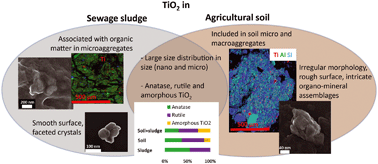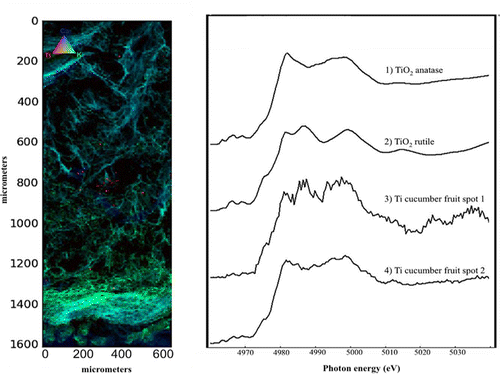Soils & sediments
Fate and transformations of nanomaterials in soils and sediments
Soils can accumulate, transform and deliver nanoparticles to plants, which is then accumulated in the food chain. The input of nanomaterials into the soil can be through fertilizers, amendmends and waste. Research at ID21 involving soils and nanomaterials focuses on the transference of nanoparticles into plants and the chemical changes of these nanomaterials in the soils.
 |
A. E. Pradas del Real, H. Castillo-Michel, R. Kaegi, C. Larue, W. de Nolf, J. Reyes-Herrera, R. Tucoulou, N. Findling, E. Salas-Colera and G. Sarret, "Searching for relevant criteria to distinguish natural vs. anthropogenic TiO 2 nanoparticles in soils", Environmental Science: Nano (2018). |
Nanosized TiO2 is one of the most produced nanomaterials. Agricultural soils are a major compartment of accumulation of TiO2-NPs after release from consumer products into the sewer system, due to the use of sewage sludge as a soil amendment. TiO2 is naturally present in soils, and distinguishing between anthropogenic and natural TiO2 in soils is thus important to assess the risks associated with the increased use of nano-TiO2. Methods to distinguish these materials in complex matrices such as soils are currently lacking. The purpose of this study was, therefore, to search for characteristic physical and chemical properties of natural and engineered nano-TiO2, based on a combination of bulk, micro and nanofocused X-ray fluorescence and X-ray absorption spectroscopy, transmission electron microscopy, X-ray diffraction and chemical analyses. Digested sewage sludge, agricultural soil and sludge-amended soil were studied by these techniques. The particle size distribution was not a relevant criterion since the sludge and the sludge-amended soil contained a variety of nanometer- and micrometer sized Ti-containing particles. Both the sludge and the soil contained a mixture of rutile and anatase, with a minor proportion of amorphous TiO2. In the sludge, there was no trend relating particle size and Ti mineralogy. The morphology of the TiO2 particles proved to be different in the two matrices, with smooth faceted particles in the sludge and rough irregular ones in the soil. In addition, natural TiO2 particles were included in micro and macroaggregates of the soil and formed intricate assemblages with minerals and organic compounds. In the sludge, TiO2 formed homo and heteroaggregates of simpler structure, richer in organic matter. Thus, the study of the morphology of TiO2 particles and their status in unperturbed mineral–organic assemblages may provide some insights into their origin. The observed differences may attenuate over time, due to the incorporation of the sludge material within the soil structure.
 |
A. D. Servin, M. I. Morales, H. Castillo-Michel, J. A. Hernandez-Viezcas, B. Munoz, L. Zhao, J. E. Nunez, J. R. Peralta-Videa and J. L. Gardea-Torresdey, "Synchrotron Verification of TiO2 Accumulation in Cucumber Fruit: A Possible Pathway of TiO2 Nanoparticle Transfer from Soil into the Food Chain ZnAl2−xCrxO4", Environmental science & technology, 47, 11592-11598 (2013). |
The transfer of nanoparticles (NPs) into the food chain through edible plants is of great concern. Cucumis sativus L. is a freshly consumed garden vegetable that could be in contact with NPs through biosolids and direct agrichemical application. In this research, cucumber plants were cultivated for 150 days in sandy loam soil treated with 0 to 750 mg TiO2 NPs kg–1. Fruits were analyzed using synchrotron μ-XRF and μ-XANES, ICP-OES, and biochemical assays. Results showed that catalase in leaves increased (U mg–1 protein) from 58.8 in control to 78.8 in 750 mg kg–1 treatment; while ascorbate peroxidase decreased from 21.9 to 14.1 in 500 mg kg–1 treatment. Moreover, total chlorophyll content in leaves increased in the 750 mg kg–1 treatment. Compared to control, FTIR spectra of fruit from TiO2 NP treated plants showed significant differences (p ≤ 0.05) in band areas of amide, lignin, and carbohydrates, suggesting macromolecule modification of cucumber fruit. In addition, compared with control, plants treated with 500 mg kg–1 had 35% more potassium and 34% more phosphorus. For the first time, μ-XRF and μ-XANES showed root-to-fruit translocation of TiO2 in cucumber without biotransformation. This suggests TiO2 could be introduced into the food chain with unknown consequences.



